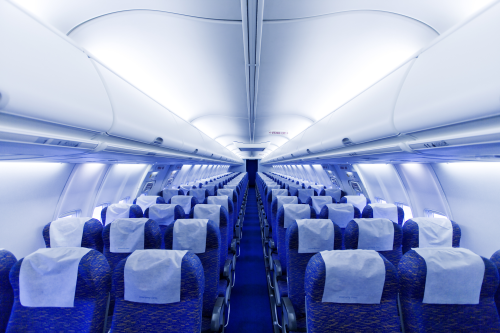
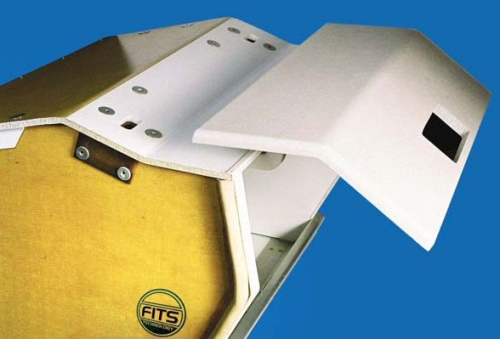
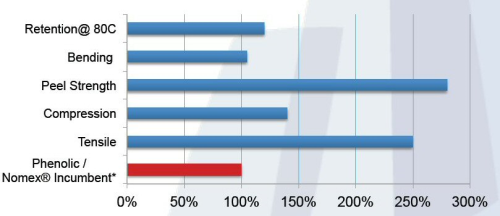
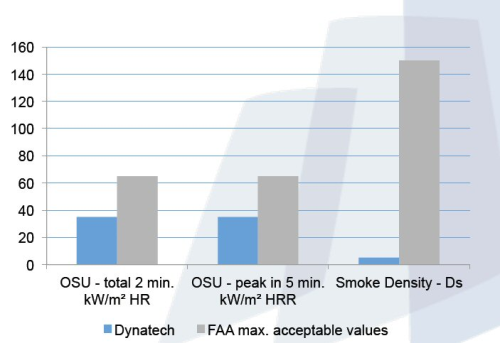
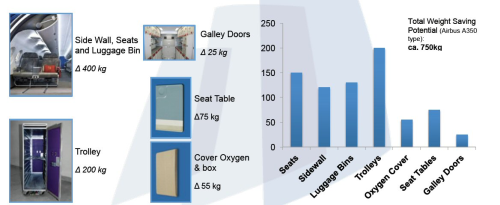
The Dynatech sandwich panel can be used to manufacture complex shaped parts, including seats, overhead bins, sidewalls, trolleys, galleys, tables, and doors.
One-polymer system
Developed from the Foamed In-situ Thermoplastic Sandwich (FITS) technology patented by Dutch company FITS Technology, the panel is based on one polymer – PEI (polyethylenimine) – and comprises a PEI in-situ foamed foam core sandwiched between fibre reinforced PEI facings. In the panel manufacturing process, the isotropic (vertical oriented) foam core is produced and the fibre reinforced facings bonded to it in one step.
Dynatech is reported to offer a 20-40% weight saving potential and a 10-30% cost saving potential over materials currently in use, including sandwich panels based on phenolic resin/Nomex® honeycomb and those based on aluminium. It also offers better mechanical performance and higher fire, smoke and toxicity (FST) values.
SMTC, a manufacturer of aluminium-based sandwich panels for the transportation sector, plans to start mass production of the Dynatech thermoplastic panels in 2016. Pilot trials are currently underway.
Why thermoplastic?
At a press conference to launch Dynatech, Christophe Jenny, CEO of SMTC, explained why the company is investing in this technology.
SMTC has 30 years’ experience in designing and manufacturing sandwich panels and its current focus is on producing lightweight interior parts for the mass transportation industry. Its customers are OEMs and Tier 1 suppliers in the train, aircraft and shipbuilding industries, including Alstom, Siemens, and Zodiac Aerospace.
To meet the future requirements of these customers – including fuel savings and CO2 emissions reduction, lower costs, and improved passenger comfort and safety – SMTC realised a new technology was required to compete with current materials. Following a year of market research, it concluded that a thermoplastic sandwich panel was the best solution.
During its research, SMTC connected with Martin de Groot, the inventor of the FITS system. After performance tests and discussions with OEMs, the feedback was very encouraging and SMTC decided to license and invest in the technology. To help it bring Dynatech to market, SMTC worked with business development consultancy AMAC GmbH, of Germany.
Benefits of Dynatech
According to SMTC's studies (Figure 1), Dynatech has better peel, compression and tensile strengths than phenolic/Nomex panels, the technology predominantly applied today.
Aircraft interior materials flammability (OSU) tests, verified by Airbus and Boeing, also confirmed low FST values for Dynatech (Figure 2).
Panels can be manufactured with a thickness of 3.2-25 mm, with an in-situ foam density of 80-250 kg/m3 and facing thicknesses of 0.1-0.6 mm. Because it is a thermoplastic system, Dynatech is easy to thermoform and shape and parts can be manufactured in a few minutes.
Finishing operations, such as edge closing, folding, adding inserts and integration of local reinforcements, are quick and easy. They can also be automated as opposed to the manual operations common with Nomex thermoset panels.
Typically in thermoset/Nomex constructions 25% of the panel weight is added to the part weight through the application of potting compound, fillers, paint, a decorative layer, connections, etc. With the thermoformable Dynatech thermoplastic sandwich panels, this figure is only 5%.
Dynatech parts are also recyclable. For example, the part could be ground and used as a short fibre injection moulding material.
Big weight savings for aircraft
Reducing the weight of aircraft leads to better fuel efficiency (and reduced CO2 emissions), and lower costs. A figure of €400-600 per kg of weight saved is commonly quoted. This is leading to increased use of lightweight composite materials in aircraft. The airframe of the Airbus A350, which made it first flight last year, is more than 50 wt% composite.
The Dynatech technology targets interior parts. A large aircraft will contain around 6 tonnes of interior parts such as side wall panels. SMTC has estimated the weight savings Dynatech could offer for various parts. For a trolley, for example, the estimated weight saving is 200 kg, while for a a galley door it is 25 kg (Figure 3). This exercise gave a total estimated weight saving per aircraft of:
- 400-500 kg for smaller aircraft such as the Airbus A320; and
- 750-1500 kg for larger aircraft like the Airbus A350 or A380.
Over an aircraft's lifetime these saving would lead to large cost savings. For example, over 20 years, 1 tonne of weight saved could lead to a fuel savings of €3 million, and a CO2 reduction of 120 tonnes.
Next steps
This year sees SMTC start pilot production of Dynatech panels. It will also begin qualifying the product with customers in the aerospace and rail industries.
In 2015, SMTC will invest in a large production facility in France for manufacturing the panels, and also shaping them into parts. The company expects this high-volume production line to be running in 2016. ♦
This article will be published in the July/August 2014 issue of Reinforced Plastics magazine.
The digital edition of Reinforced Plastics is distributed free of charge to readers who meet our qualifying criteria. You can apply to receive your free copy by completing this short registration form.






